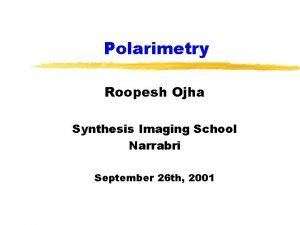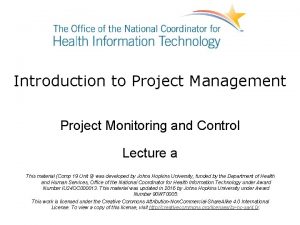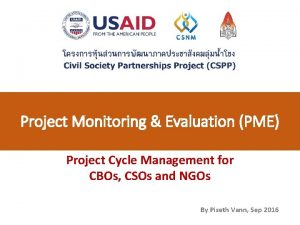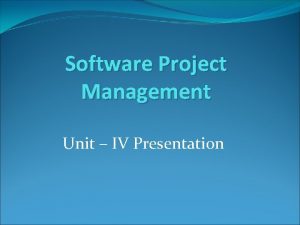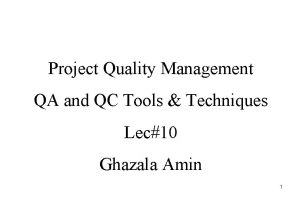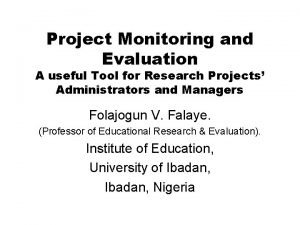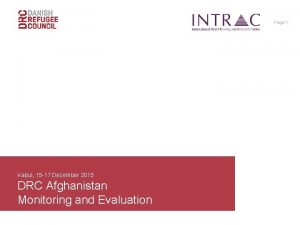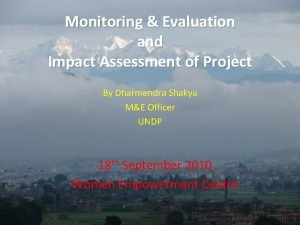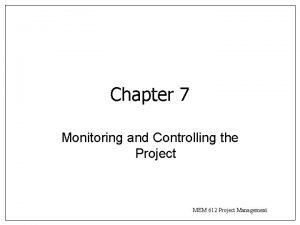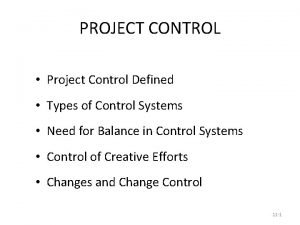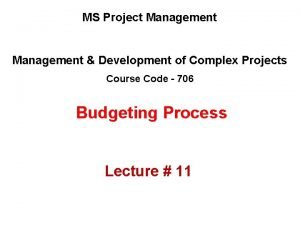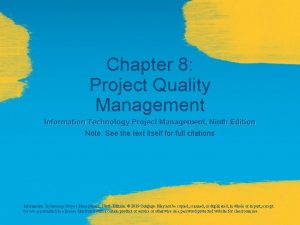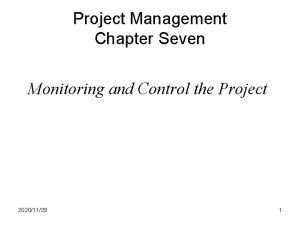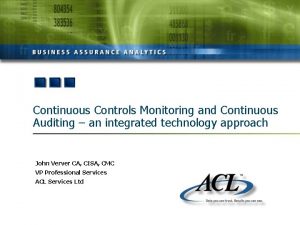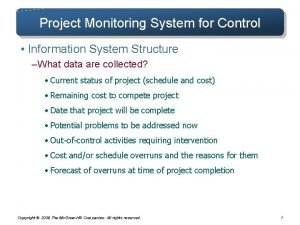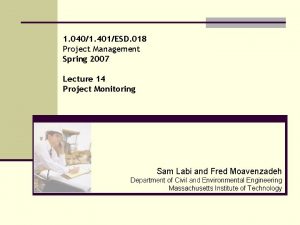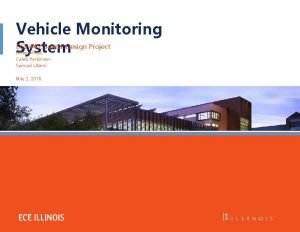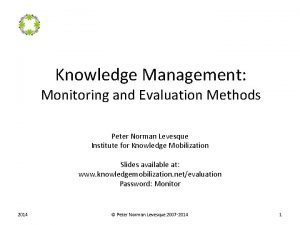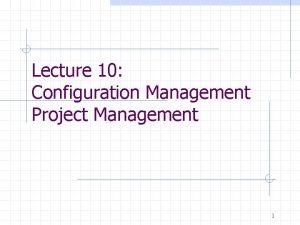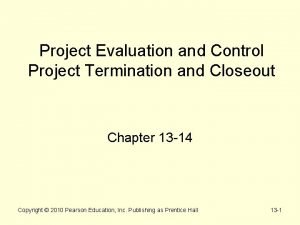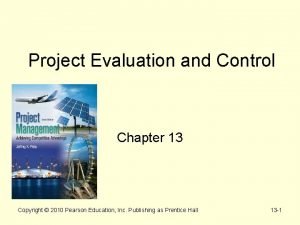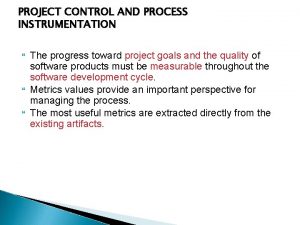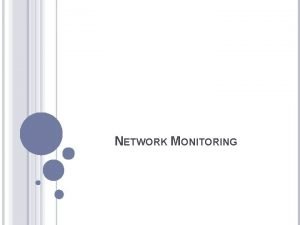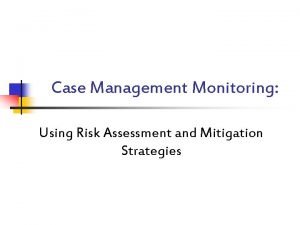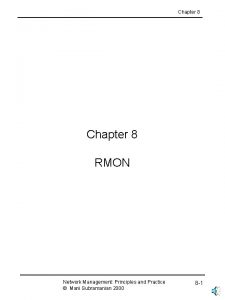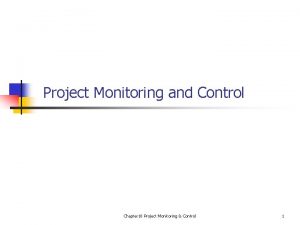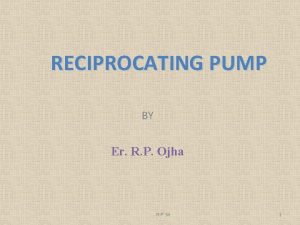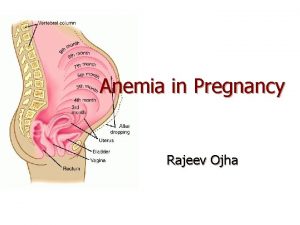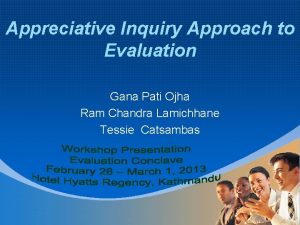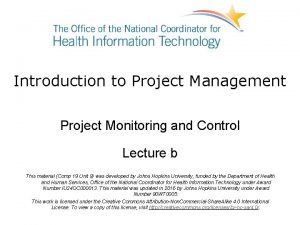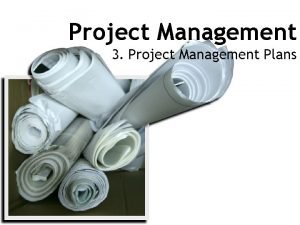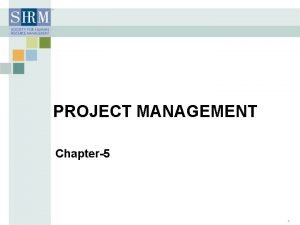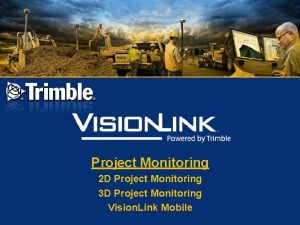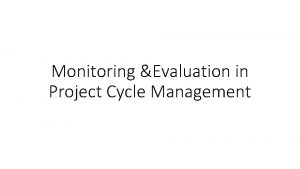Project Management Monitoring and Control D K OJHA


















































- Slides: 50

Project Management – Monitoring and Control D. K. OJHA, Director (IPMD) Mo. SPI, New Delhi 1

Project Management q What is a Project ? Ø q A project is a temporary endeavour undertaken to create a unique product or service. What is Project Management ? Ø Project management is the discipline of planning, organizing, securing, and managing resources to achieve specific goals (project). 2

Project Management Process Areas q q q A process is a series of actions directed toward a particular result. Project management can be viewed as a number of interlinked processes. The project management process groups include: Ø Ø Ø Initiating processes Planning processes Executing processes Monitoring and controlling processes Closing processes 3

Level of Activity and Overlap of Process Groups Over Time 4

What is Monitoring and Controlling ? q Ø Monitoring collecting, recording, and reporting information concerning project performance that project mangers and others wish to know. Controlling uses data from monitor activity to bring actual performance to planned performance. 5

Exercise ACTIONS Process Group Determine high level Risks Initiating Measurement against performance measurement baseline M&C Implement Approved Change, Corrective actions Execution Re-analysing Existing Risks M&C Verify the project meets the exit criterion Closing Hold team building Exercise Execution Risk Audit M&C Increase the effectiveness of the processes Execution Create forecasts M&C Plan what will be communicated , to whom, By whom, Planning when and why

Actions Process Group Quality Audits M&C Determine how you will improve the process in use on the project Planning Determine measurable project & product deliverables Initiating Manage time and cost overruns M&C Gather final lessons learned Closing Implement quality assurance procedures Executing Identify high level Stakeholders & their influences Initiating Add new skills required to team members HR records Closing Meet with managers to gain resource commitments Planning Use EVA M&C Ensure common understanding of the work Execution Ensure the product scope is final & Practical Initiating

Actions Process Group Create final report of project performance Closing Index and archive project records Closing Determine the Team Planning Look for new RISKS M&C Request Change M&C Go back-Iterations Planning Administer procurement M&C Manage reserves M&C Perform Risk audit M&C Perform Quality Control M&C Give recognition and rewards Executing Facilitate conflict resolution Executing

Process group and Knowledge area Relationship 9

Process group and Knowledge area Relationship – Cont’d. 10

What to Monitor ? Human Resources q Machines q Materials q Cost q Time q Activities q Quality/Technical Performance q 11

How to Monitor ? q q q q Stakeholders Meetings For schedule – Critical Path Analysis, PERT Charts, Gantt Charts Using Earned Value Analysis Milestones Reports Tests and inspections Delivery or staggered delivery PMIS (Project Management Info Sys) 12

IPMD, Mo. SPI The Infrastructure & Project Monitoring Division of Programme Implementation Wing in Mo. SPI is the management arm of the Government of India. The work relating to monitoring of production performance of the Infrastructure Sectors was transferred from Cabinet Secretariat to Mo. SPI since its creation in 1986. Role: Ø Ø Ø To monitor infrastructure development through projects. To provide management support to the Ministries/Departments in timely completion of projects. To facilitate resolution of complex problems impeding progress of projects To bring improvement in systems and procedures relating to project formulation, planning, approval, implementation, monitoring and evaluation. To strengthen project management profession through institutional development, capacity building, training etc. 13

Objectives of monitoring of Infrastructure sectors Ø Ø Main objective of infrastructure monitoring is to closely monitor the operational performance parameters of the infrastructure sectors of the economy. Focus of monitoring is primarily to achieve the production targets and requisite growth rates and to bring to notice of top production targets to enable them to take remedial measures for effective and meaningful implementation of the programmes for rapid growth. 14

OCMS – Project Management Info System To help IPMD, Mo. SPI achieve its objectives, there was need to develop a secure system which would facilitate collection, processing and analysis of data pertaining to GOI infrastructure project. Core objectives of Online Computerised Monitoring System (OCMS) are: ØTo reinforce the mechanism for monitoring the implementation of projects; leading to development of efficient monitoring system for GOI projects by IPMD of Mo. SPI. ØTo strengthen relationship between Mo. SPI and Project executing agencies by providing the better means of project communications. Ø To act as a facilitator in problem resolving for smooth completion of Projects 15

OCSM - Architecture 16

OCMS – Project Data Project data collected broadly fall in following categories : Ø Schedule Related Info : Approval dates, Date of commissioning, Milestones, Physical completion, Review Meetings Info, etc… Ø Financial Information: original cost, Revised Cost, Expenditure cumulative, Budget Required 17

OCMS – Project Data Ø Ø Ø Monthly Progress : Changes to dates & costs, budget & expenditure, latest status Problems reported: - Identified and steps required for their mitigation. etc Miscellaneous : Agencies can upload Gantt/ PERT/CPM charts, pictures from sites, project schedule, Closure remarks and lessons learned etc. . 18

Main Entry Form

OCMS – Direct Benefits Ø Ø Ø Ø Secure access to project information Global view of all projects Progress of a particular project Online availability of project events Recording of project experience Sharing of project knowledge across sectors Documents released by the Government of India for project partners 20

OCMS – Outputs n Some of the outputs and usage of OCMS data: Ø Ø Ø Ø Monthly Flash Reports Quarterly Report on Mega Projects (above Rs 1000 Cr) Reports for Prime Minister Office Sector wise analysis/ Reports Response to Parliament Questions Status wise analysis for, Planning Commission, RBI, EFC, PIB/CCI and MOU’s meetings etc. . 21

OCMS – Benefits from better Monitoring An analysis of cost overruns in the last 14 years with respect to the Originally approved cost shows that the cost overrun has declined from 40. 9% in March, 1999 to 19. 1% till August 2013. 22

OCMS – Benefits from better Monitoring There has been a continuous decline in the number of delayed projects over the years. A spike in the latest figures is due to exclusion of projects costing less than Rs. 150 Cr from monitoring. 23

Status of Power Projects (Aug’ 2013) 24

Status of Petroleum Projects (Aug’ 2013) Petroleum – A snapshot 25

y la ty xi pl e of ec t op e Sc US O Pr oj in e th ge IN DU S, ) od … (F lo n . . . tio qu isi Ac er an e lik Ch es sit m IP Co in st isa ra l. D tu Na & 100, 00 98, 25 96, 49 92, 98 89, 47 82, 46 18 Si te w 71, 93 59, 65 16 La s s es ad in Re y/ nc ed ia M 47, 37 14 ns ur ge ed /I ct af fe an ce ar cle es su Is 20 De E W /L ity ur er 12 Se c te ta /S pa l ici w 6 31, 58 8 M un su es Is 10 Po te d el a rr nd o Ve Pareto Analysis (Telecom) Analysis of reasons for delay in Telecom sector projects reveals that a third of the projects are suffering with Vendor management issues. 4 2 0 120, 00 100, 00 80, 00 60, 00 40, 00 20, 00 26

sa es su Is s ea s nd or es su Is s n ue Is s Ve tu al ra c rs ve r. O fo nt Co ay ra tio ne Ge t en pm Eq ui f. W ht O er w Po of m bl e 100, 00 98, 70 93, 51 87, 01 79, 22 70, 13 18 Ri g in y pp l Su 57, 14 20 Vi la y in de rp ro or 16 De la y d an nc e ra ea Cl 44, 16 14 De w La nv /E 10 st on 12 Fo re nd iti 6 24, 68 8 co n io sit qu i ac ic at lim l/c gi ca lo Ge o nd La Pareto Analysis (Power) In Power sector issues in Land acquisition is delaying a quarter of all projects. Forest/Environment clearance is also a major issue. 4 2 0 120, 00 100, 00 80, 00 60, 00 40, 00 20, 00 27

ay in g isi n al fin y la rig en t em ur oc ar ul n c. . io tig at od m pr of in s sp ec Li et 100, 00 97, 82 95, 65 93, 48 89, 13 82, 61 76, 08 69, 56 60, 87 52, 17 39, 13 23, 91 12 De e th bs jo en t pm eq ui pi ng m va re of bl em m bl e pr o k or w rp ro or de er y d an liv de in in la y de la y De la w e at of e an c ar d m an de le t. C sc op e lim er /c ea th d se vi Re re s n s ct ra es su Is nt co al 6 Fo of io pe ns at d ar aw ur 4 m co in ct ra nt 8 w gh hi qn / ac y la De 10 de l La nd Co Pareto Analysis (Petroleum) An analysis of Petroleum sector projects shows that about 40% of the projects are suffering delays due to issues related to contracts. 120, 00 100, 00 80, 00 60, 00 40, 00 2 20, 00 0 0, 00 28

Earned Value Analysis – An Introduction November 2013 29

Earned Value Analysis ØWhat Is It ? ØWhy Do I Need It ? ØHow Do It? 30

There’s Room For Improvement Ø 31% of all projects are facing cost overruns Ø 41% of all projects are facing time overruns ØAnd some, after huge investments of time and money, are simply never completed Ø Source : FR August 2013 31

How to answer the question: “Have we done what we said we’d do? ” Ø% complete estimating Ø% of Budget spent Ø% of work done Ø% of time elapsed 32

Enter Earned Value Analysis Ø“Earned Value Analysis” is: Øan industry standard way to: Ømeasure a project’s progress, Øforecast its completion date and final cost, and Øprovide schedule and budget variances along the way. ØBy integrating three measurements, it provides consistent, numerical indicators with which you can evaluate and compare projects. 33

What is more Important? ØKnowing where you are on schedule? ØKnowing where you are on budget? ØKnowing where you are on work accomplished? 34

EVA Integrates All Three ØIt compares the PLANNED amount of work with what has actually been COMPLETED, to determine if COST , SCHEDULE, and WORK ACCOMPLISHED are progressing as planned. ØWork is “Earned” or credited as it is completed. 35

Earned Value needed because. . . ØNeed to “roll up” progress of many tasks into an overall project status ØNeed for a uniform unit of measure (amount of money OR work-hours). ØProvides an “Early Warning” signal for prompt corrective action. 36

EVA – How do we do it ? ØEVA works best when work is ‘compartmentalized’. ØCompartmentalization is best achieved with a wellplanned Work Breakdown Structure. ØEach lowest level WBS* element should specify ØScope of work to be accomplished ØTotal (direct and indirect) cost ØTimeframe for completion *Details in MS Project training 37

Budgeted Cost of Work Scheduled ØBCWS - Budgeted Cost of Work Scheduled Ø Now called “Planned Value” (PV) Ø “Yearned” Ø How much work should be done? 38

Budgeted Cost of Work Performed ØBCWP - Budgeted Cost of Work Performed Ø Now called “earned value” (EV) Ø “Earned” Ø How much work is done? Ø = BCWS * % complete 39

Actual Cost of Work Performed ØACWP - Actual Cost of Work Performed Ø Now called “Actual Cost” (AC) Ø “Burned” Ø How much did the work done cost? 40

Derived EVA Variances Ø SV: Schedule Variance Ø BCWP – BCWS Ø Planned work vs. work completed Ø CV: Cost Variance Ø BCWP – ACWP Ø Budgeted costs vs. actual costs Ø Negatives are termed ‘unfavourable’ 41

Derived EVA Ratios Ø SPI: Schedule Performance Index Ø BCWP / BCWS Ø CPI: Cost Performance Index Ø BCWP / ACWP Problems in project if either of these less than 1 (or 100%) 2. Study on historical project monitoring data suggests that the CPI on a Project will vary by less than 10% after the first 20% of the a project and usually only in a negative direction. 1. 42

Other Derived Values Ø BAC: Budget At Completion Ø Sum of all budgets (BCWS). The original budget. Ø EAC: Estimate At Completion Ø Ø Forecast total cost at completion EAC = ((BAC – BCWP)/CPI) + ACWP Unfinished work divided by CPI added to sunk cost If CPI < 1, EAC will be > BAC Ø CR: Critical Ratio Ø Ø Ø SPI x CPI 1: everything on track >. 9 and < 1. 2 ok 43

EVA – Graphical Representation 44

EVA – An Example As of 1 -July where are we? BCWS = ? BCWP = ? ACWP = ? 45

EVA – An Example As of 1 -July where are we? BCWS = PV = 65, 000 BCWP = EV = 50, 000 ACWP = AC = 45, 000 46

EVA – An Example SV = ? CPI = ? CV = ? CR = ? SPI = ? EAC = ? 47

EVA – An Example SV = EV – PV = -15, 000 CPI = EV/AC = 1. 11 CV = EV – AC = 5, 000 CR = SPI * CPI =. 854 SPI = EV/PV =. 769 EAC = ((BAC – EV)/CPI) + AC= 72, 750 48

SUMMARY ØBenefits Ø Consistent unit of measure for total progress Ø Consistent methodology Ø Across cost and completed activity Ø Apples and apples comparisons Ø Ability to forecast cost & schedule Ø Can provide warnings early ØSuccess factors Ø A full WBS is required (all scope) Ø Beware of GIGO: Garbage-in, garbage-out 49

IPMD, Mo. SPI 50
 Roopesh ojha
Roopesh ojha Dhirendra ojha
Dhirendra ojha Monitor and control project work
Monitor and control project work Traditional vs modern project management
Traditional vs modern project management Project cycle management ngo
Project cycle management ngo Prioritizing monitoring in software project management
Prioritizing monitoring in software project management Qa tools and techniques
Qa tools and techniques Differences between monitoring and evaluation
Differences between monitoring and evaluation Example of monitoring and evaluation in project proposal
Example of monitoring and evaluation in project proposal Objective of evaluation
Objective of evaluation Plan monitor control cycle
Plan monitor control cycle Cybernetic control project management
Cybernetic control project management Control accounts project management
Control accounts project management Project management quality control
Project management quality control Project management quality control
Project management quality control Go no go control project management
Go no go control project management The role of project management in achieving project success
The role of project management in achieving project success Iteration workflows in software project management
Iteration workflows in software project management How to reduce project duration
How to reduce project duration Modern project management began with what project
Modern project management began with what project Project evaluation in software project management
Project evaluation in software project management Types of project audit in project management
Types of project audit in project management Microsoft project agile project management
Microsoft project agile project management Project termination types
Project termination types Ccm continuous controls monitoring
Ccm continuous controls monitoring Continuous control monitoring definition
Continuous control monitoring definition Control loop performance monitoring
Control loop performance monitoring Eacf project management
Eacf project management Project monitoring meaning
Project monitoring meaning Vehicle monitoring system project
Vehicle monitoring system project Knowledge management monitoring and evaluation
Knowledge management monitoring and evaluation Asset management vs project management
Asset management vs project management Configuration management system pmp
Configuration management system pmp Principles of project cost management
Principles of project cost management Define software configuration management
Define software configuration management Project integration management example
Project integration management example Dairy plant management
Dairy plant management Lac operon positive control
Lac operon positive control Control flow errors
Control flow errors Project evaluation and control
Project evaluation and control Project evaluation and control
Project evaluation and control Project control and process instrumentation
Project control and process instrumentation Cost control and cost reduction project report
Cost control and cost reduction project report Cost control and cost reduction project report
Cost control and cost reduction project report Network monitoring definition
Network monitoring definition Case management monitoring
Case management monitoring Rmon in network management
Rmon in network management Pyramid levels of management
Pyramid levels of management Top management middle management first line management
Top management middle management first line management Top level management
Top level management Translational research institute on pain in later life
Translational research institute on pain in later life
